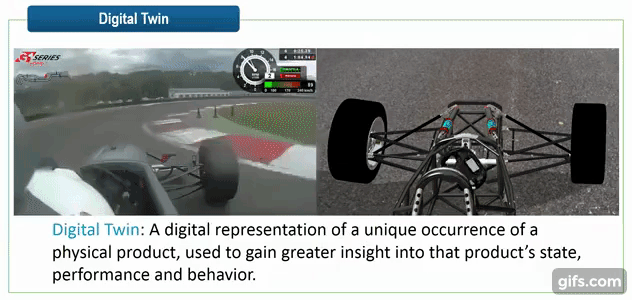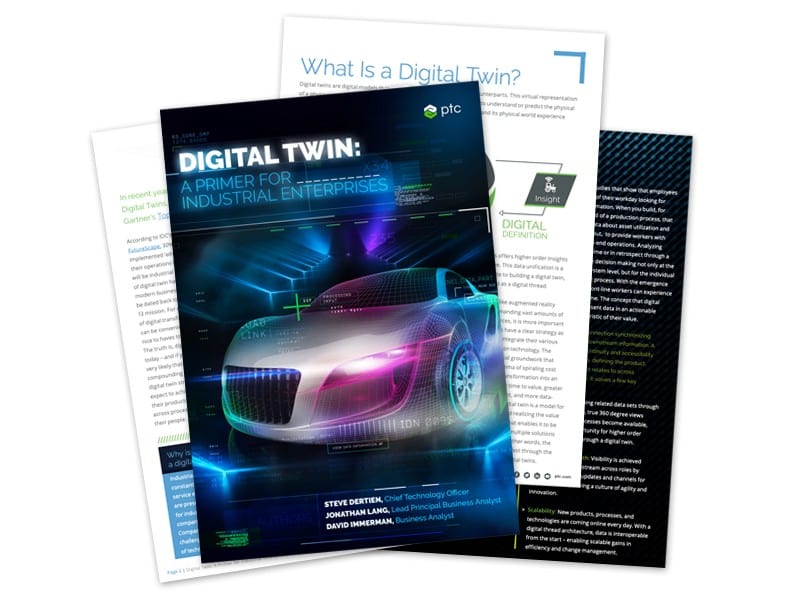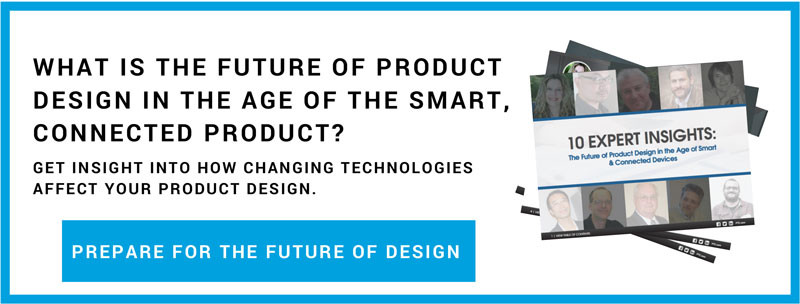The Internet of Things (IoT) is transforming the way companies design, manufacture, and service their products and manufacturing floors. ‘Service’ is one of the most notable areas to be impacted by this wave of technology and connected devices. Monitoring assets in the field and on the shop floor gives service technicians access to usage, error, and predictive analytics prior to a repair. As companies continue to adopt the IoT, more organizations are satisfying the prerequisites to easily deploy augmented reality for service.
With the convergence of the digital and physical worlds, manufacturers are using augmented reality as a tool to help improve their service capabilities. Augmented Reality (AR) can deliver the right information at the very moment that it’s needed on the manufacturing floor so that field service technicians and other factory workers can reduce errors, enhance efficiencies, and improve productivity. AR also allows for content to be presented in arguably the most contextual way possible. When accurate information is presented over real-world devices there is little room for error and misunderstanding.
If field service technicians aren’t available to be on-site for a critical situation, then technicians can remotely assist customers with the help of AR. Customers will be able to observe service manuals with interactive 3D animations to disassemble components or work on equipment with which they’re unfamiliar with. If the users need further help, then the experienced field service technician can walk users through instructions while steaming the user’s device view in real time.
Augmented Reality Barriers to Entry
Your service and parts information have to be accurate and up-to-date in order to fully benefit from an augmented reality investment. Making sure your organization has a reliable Service Lifecycle Management system in place is the first step to digital transformation. Without accurate information on parts and equipment, field service technicians could replace the wrong part or be confronted with an outdated, undocumented design.
In order to be labeled a “smart connected enterprise,” a company should have a strategy to connect all of their assets and data; this includes technical publications. Connected technical illustrations have the power to show the current status for every part and piece of equipment. For example, if a mechanic could see a 3D representation of a vehicle’s carburetor and view critical metrics it would help them understand the potential for repairs or future failure.
Your organization needs to be IoT ready – meaning that there needs to be a strategy in place to input sensors on products and equipment. The Internet of Things allows products and assets to send alerts to a maintenance system that assigns a field service technician to perform a repair. Without the sensors that relay information about the status of those parts, and accurate 3D representations, augmented reality devices would be useless because there would be no relevant or up-to-date information to leverage in the field.
The IoT and Augmented Reality are transforming service and enhancing the field service process. Check out EAC’s solutions to see how you can start using AR today.
Here’s how connected products are changing service.
Connected products optimize business processes
Lets face it, business is all about efficiency – taking costs and time out of products and processes. This is exactly how connected products optimize business processes.
Connected products provide organizations with access to real-time data that is combined with existing system information to increase efficiency.
For example, you could provide data about your products condition in the field. By doing so, your technicians can be better prepared to troubleshoot. This can reduce the number of onsite visits because technicians have the right instructions or tools required to quickly repair an asset.
Implementing a connected product strategy can improve your first-time fix rate, decrease truck rolls and service calls, and increase the efficiency of your delivery model.
Connected products improve customer experience
Connected products also positively impact customer experience.
Customers recognize more service value when issues are resolved in one call or service visit. Connected products arm your service team with the information necessary to quickly and effectively address service requests and increase customer satisfaction.
Customer satisfaction correlates to service renewals.
Connected products differentiate offerings
With the use of a connected product platform, your organization will be able to increase the pace of product and service innovation, proactively diagnose and service your products all while increasing the speed of your service delivery.
For instance, if your hardware was a commodity or under heavy competitive pressure, improving the software, applications, and service that came along with your products could help differentiate your offering and help you outpace the competition.
Connected products drive new revenue streams
Connected products help drive new revenue streams by unlocking new business models, reducing customer downtime, meeting SLA’s, and by providing offerings such as “product as a service”. Would your company rather wait for occasional service revenue to come in, or would you rather intelligently monitor, maintain, and update your products for a consistent recurring fee?
Information will fuel the future of products and services. Data can be used to improve, differentiate, and optimize your business. The impact the Internet of Things has had on service delivery and customer experience is staggering. Delivering connected products is the first step to realizing the benefits of a connected product service strategy. We’d like to help you realize your strategy, implement industry-leading solutions, and support your implementation and deployment. Let’s connect.
Engineers leverage simulation tools to develop innovative and high-performing products in a virtual design space using computer-aided design (CAD) technology.
Imagine what you could do as a designer or engineer if you could take your simulation a step further and study a digital working copy of a product under actual working conditions. It could help you rapidly optimize the design, life, and maintenance of a product.
What is a digital twin?
Companies are collecting real-time operating data from product-mounted sensors. They use the data to create an exact replica of a working product, process, or service. This exact replica, called a digital twin, is a simulated model in a virtual space that performs under real-world conditions to help companies find performance issues, schedule predictive maintenance, reduce downtime, and minimize warranty expenses.
Digital twins drive innovation and performance. They give product development technicians predictive analytics and they give companies the ability to improve customer experience. Digital twins allow for better understanding of customer needs, enhanced existing products, streamlined operations, and improved service-after-sales; all while creating headway for new products and services.
The Internet of Things (IoT) has made it possible for digital twins to exist. IoT platforms bridge the gap between the digital and physical world. How does it work? Smart connected products and smart connected operations are connected to a cloud-based system that receives and processes all the data monitored by sensors.
Using the data captured by sensors, the simulation model, or digital twin, is continuously updated and gives designers and engineers the insight they need to improve future product development efforts. (An example would be visibility into real-world bearing operating temperatures and the downstream effects on tolerances right within a CAD model.)
By studying the digital twin under actual working conditions, companies can see the product in action. Engineers can make more informed choices during the design process and use digital twins to make their simulations more accurate.
Bringing digital twins to life with the Internet of Things
For businesses already using engineering simulation to design products, connecting the simulation to the physical product in the field is necessary to deploy the digital twin solution.
For businesses that are new to simulation, the engineering team would first need to build the 3D product model, optimize its performance, and replicate the real world in which the product system would operate. Re-using this data in similar product simulation scenarios for future product development saves time and money.
In process of applying a digital twin to your design is explained in PTC’s blog as follows:
- Build a product using 3D CAD
- Build a physical prototype of the product
- Add sensors to the prototype
- Build the sensors in the 3D CAD model
- Collect the data (E.g., via ThingWorx)
- Associate the sensors’ data streams to the sensors in your 3D CAD model
- Voila! Now your model can talk.
Not only do digital twins improve future innovation and product development efforts for designers and engineers – they build a stronger relationship between engineering and operations teams.
The data collected from sensors is analyzed by the operations team to optimize performance, service, and maintenance over the lifetime of a product. The digital twin can help organizations avoid costly downtime, repairs, replacements, or stay ahead of other performance issues.
The rapid development of technology has transformed traditional modeling methodologies and provided new ways to deliver digital 3D models and product data. Computer-aided design (CAD) now gives users the tools used in all stages of product development from concept development to final presentation. Not only are the products changing with technology advances, the tools we use to design the products are changing too.
So how exactly is augmented reality changing the way you do your work? Here are 3 ways Augmented Reality is reinventing your design process.
AR makes your workspace way more flexible
You won’t have to be constrained to your desk to design products anymore. AR allows you to take your design beyond where you traditionally have done the bulk of your work. With the help of smart glasses, tablets, and mobile phones, you can design, and experience your designs anywhere you want whether it’s at your desk, in a conference room, or on a shop floor.
AR allows you to fully conceptualize designs
Digitally generated 3D models created within CAD software have a limitation – the rendering of the design is still stuck inside of a flat screen. Augmented reality allows you to fully conceptualize designs when they’re superimposed on the physical world. Augmented reality allows you to sit inside your design as you’re creating it – enhancing engineers’ ability to evaluate and improve designs. This lets you fully appreciate characteristics of a design at full, partial, or expanded scale in its intended setting.
AR reduces time and money spent on prototyping
Augmented reality gives designers and engineers the ability to view accurate representations of finished products in real-world scenarios without expensive prototypes. It eliminates the constant need to build multiple and costly prototypes because you’re able to see any design flaws in a half virtual, half physical world. By the time you’re ready to send your draft to a 3D printer or manufacturer, you’re already very confident in your design.
If you’re not already using AR in your design process, it probably won’t be long before you are. Companies like PTC are leading the way to innovation and new design processes by integrating Augmented Reality (AR) capabilities into their CAD software, Creo Parametric. Creo AR allows you to rapidly create AR experiences directly from Creo, easily manage and control viewer access, rapidly distribute and share AR experiences, and effectively communicate and collaborate design information.
Start creating, publishing, and sharing augmented reality experiences with Creo AR – download the datasheet to learn more.
This is a guest post from our friends over on the PTC blog.
This week in Chicago, IoT business and IT leaders from multiple industries came together at Bosch Connected World to share best practices and case studies around connected products, services, and solutions.
During the conference, the emerging trend of using augmented reality in manufacturing was explored in a keynote on Wednesday by PTC CEO and IoT expert and visionary, Jim Heppelmann, where he shared a research-driven framework for how companies can capitalize on the convergence of the physical and digital worlds.
Heppelmann emphasized the experiences and opportunities augmented reality is creating for competitive advantage in the IoT.
With the number of smart, connected products increasing each day, the volume of data generated continues to grow, presenting both challenges and opportunities. More data is being created than humans can possibly consume, which creates the need for new processes and applications to address this challenge. The ability to make this information more digestible, while also being able to identify what is valuable and requires action, will become a key competitive advantage. Data analytics is one way to take this large amount of data and condense it to a smaller actionable amount, but AR presents another level of opportunity to redefine the way we as humans absorb and learn from this information.
The excitement over AR’s ability to change the way we consume and communicate information is getting a lot of attention. Recently, Apple CEO Tim Cook weighed in on his view that AR will be bigger than VR in an interview with ABC, saying, “…my own view is that augmented reality is the larger of the two, probably by far, because this gives the capability for both of us to sit and be very present, talking to each other, but also have other things — visually — for both of us to see.”
Last week, an article in The Huffington Post also addressed how AR can offer tangible benefits by providing a more immersive form of education and training. As evident in Heppelmann’s keynote at Bosch Connected World, this can be very valuable in a business or manufacturing setting.
Using AR to ‘educate’ in a business setting opens up a vast amount of possibilities for addressing the many challenges that manufacturers across industries face in the age of IoT, including:
• Being able to better understand IoT data and make it actionable
• Marketing and selling smart, connected products
• Overcoming the manufacturing skills gap by optimizing training through simulation, which leads to better retention of information
• Changing the way service information is consumed and the way smart, connected products are serviced
The use of AR in enterprise will continue to grow. It is not only changing the way we interact with things, but also holds a lot of promise for increasing our understanding of information and improving the way we work.
There’s a lot of buzz around the Internet of Things (IoT) these days and the phrases getting manufactured and tossed around are confusing a lot of my friends.



